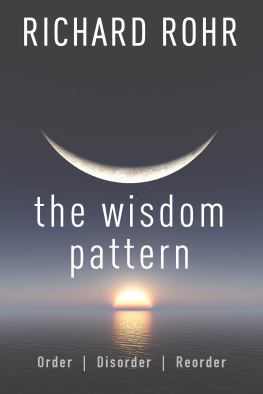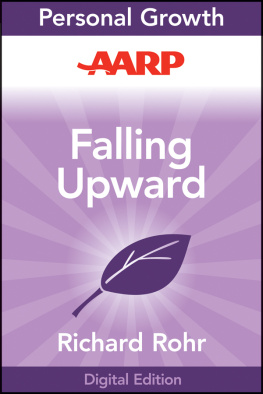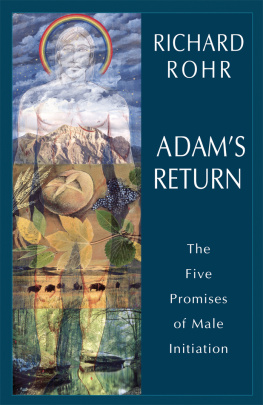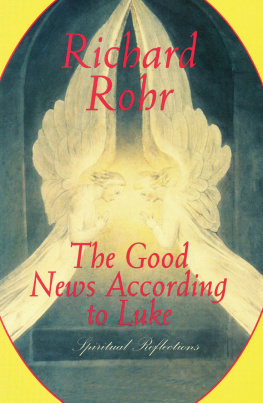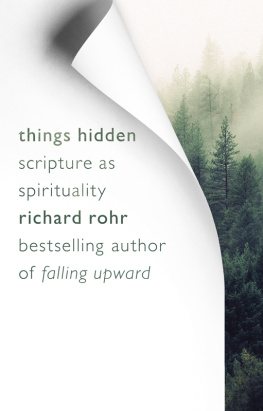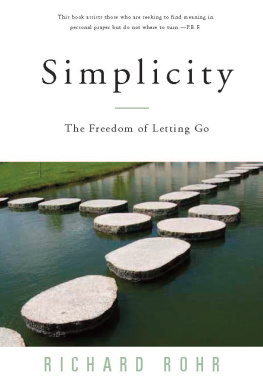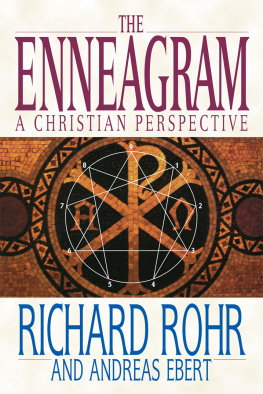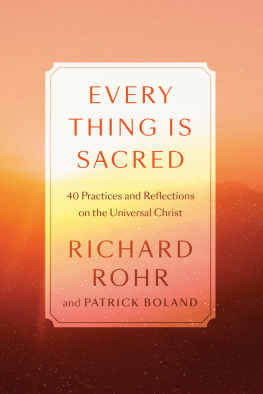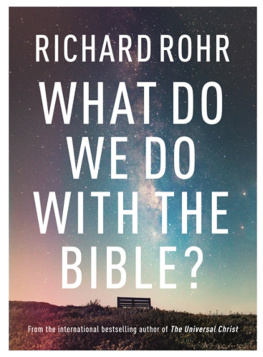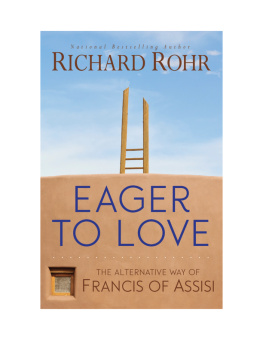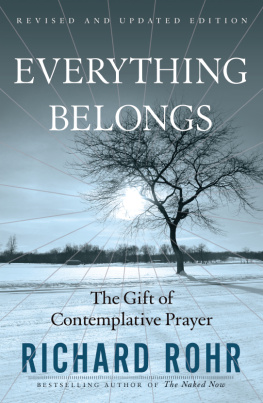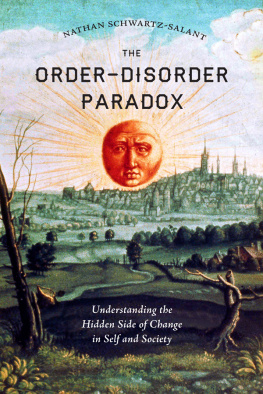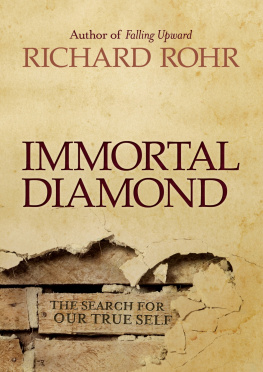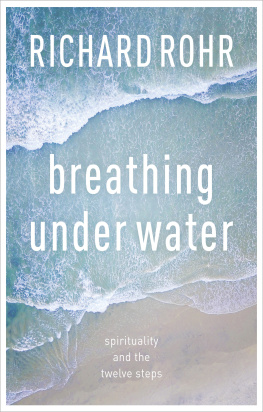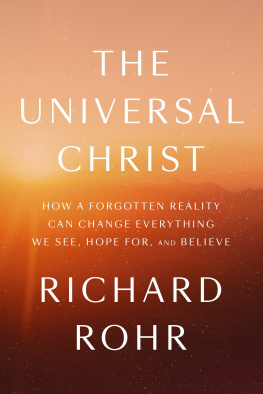

A BOUT THE A UTHOR
Richard Rohr, OFM, is a Franciscan priest of the New Mexico Province and the Founding Director of the Center for Action and Contemplation in Albuquerque, New Mexico. An internationally recognized author and spiritual leader, Fr. Richard teaches primarily on incarnational mysticism, non-dual consciousness, and contemplation, with a particular emphasis on how these affect the social justice issues of our time. Along with many recorded conferences, he is the author of numerous books, including his newest, The Universal Christ: How a Forgotten Reality Can Change Everything We See, Hope For, and Believe and What Do We Do with Evil? To learn more about Fr. Richard Rohr and the CAC, visit https://cac.org/richard-rohr/richard-rohr-ofm/.
ACKNOWLEDGMENTS
The author would like to acknowledge the inspiration and constant encouragement of Fr. Jeremy Harrington, OFM, and Sr. Pat Brockman, OSU.
This book began as part of the audiocassette series, Rebuild the Church: Richard Rohrs Challenge for the New Millennium (St. Anthony Messenger Press). Chapter Two was adapted from a talk Richard gave at the Archdiocese of Los Angeles Religious Education Congress in 1998. All of the material was rewritten, expanded, and somewhat reorganized for this second edition of the book. The author apologizes for any shortcomings from the transition from speech to the written word.
Franciscan Media is a nonprofit ministry of the Franciscan Friars of St. John the Baptist Province. Through the publication of spiritual books, St. Anthony Messenger magazine, and online media properties such as Saint of the Day, Minute Meditations, and Faith & Family, Franciscan Media seeks to share Gods love in the spirit of St. Francis of Assisi. For more information, to support us, and to purchase our products, visit franciscanmedia.org.

CHAPTER ONE
The Postmodern Opportunity

O NE REASON SO MANY PEOPLE HAVE LOST HEART TODAY IS THAT WE FEEL both confused and powerless. The forces against us are overwhelming, including consumerism, racism, militarism, individualism, patriarchy, and the corporate juggernaut. These powers and principalities (Ephesians 6:12) seem to be fully in control. We feel helpless to choose our own lives, much less a common life, or to see any overarching meaning in it all.
This became all the more evident after the horrific terrorist attacks of September 11, 2001. Everything that had seemed so importantstock options, consumer choices, increasingly affluent lifestylessuddenly faded. Church attendance increased immediately. Religious websites experienced a surge in activity. We saw a wave of patriotism unseen for decades. Some people even had the courage to look into our collective conscience and start questioning if the developed nations have been doing enough to help eradicate poverty worldwide.
In the two decades since 9/11, we have seen additional fractures develop in American society and around the world, along with global threats such as the COVID-19 pandemic. Patriotism has become divisive rather than inclusive. That surge in church attendance is a distant memory and smaller churches are further challenged as worship moves online through months of social distancing. There is much less belief in the possibility of a common life than there was in the months after 9/11, although shelter-in-place is bringing out a few hopeful signs such as balcony singalongs and spontaneous online gatherings. Its clear that America is not the only country struggling with these issues. All of this points to a long-standing, deep need for social reconstruction that we must urgently address.
More than anything else, I believe, we are facing a crisis of meaning The world seems so complex, and we seem so small. What can we do but let the waves of history carry us and try to keep afloat somehow?
Perhaps we can at least look to that same history for some patterns, or for those who found the patterns. That is the intention of this book. In that sense, this is a very traditional book, even though many of these patterns form revolutionary suggestions. I will point particularly to the man who has one of the longest bibliographies of anyone in history: an Italian friar called Francis of Assisi (11821226). He must have had some kind of genius to have attracted people in so many cultures and religions, and to seem contemporary in so many of his responses eight hundred years later.
Franciss Context and Reference Points
Saint Francis of Assisi stepped out into a world being recast by the emerging market economy. He lived amid a decaying old order in which his father was greedily buying up the small farms of debtors and moving quickly into the new entrepreneurial class. Francis stepped into a church that seems to have been largely out of touch with the masses. He trusted a deeper voice and a bigger truth. He sought one clear center and moved out from there.
His one clear centerpiece was the Incarnate Jesus. Francis understood everything else from that personalized reference point. Like Archimedes, Francis had found his one firm spot on which to stand and from which he could move his world. He did this in at least three clear ways.
First, he walked into the prayer-depths of his own tradition, as opposed to mere religious repetition of old formulas. Second, he sought direction in the mirror of creation itself, as opposed to mental and fabricated ideas or ideals. Third, and most radically, he looked to the underside of his society, to the community of those who had suffered, for an understanding of how God transforms us. In other words, he found depth and breadthand a process to keep us there.
The depth was an inner life where all shadow, mystery, and paradox were confronted, accepted, and forgiven. Here, he believed God could be met in fullness and truth. The breadth was the actual world itself, a sacramental universe. It was not the ideal, the churchy, or the mental, but the right-in-front-of-us-and-everywherethe actual as opposed to the ideal.
Francis also showed us the process for staying therethe daring entrance into the world of human powerlessness. His chosen lens was what he called poverty and, of course, he was only imitating Jesus. He set out to read reality through the eyes and authority of those who have suffered and been rejectedand come out resurrected. This is apparently the privileged seeing that allows us to know something that we can know in no other way. It is the unique baptism with which Jesus says we must all be baptized (see Mark 10:39). My assumption in this book is that this is the baptism that transforms. It is larger than any religion or denomination. It is taught by the Spirit in and through reality itself.
We can argue doctrinally about many aspects of Jesuss life and teaching, but we cannot say he was not a poor man, or that he did not favor the perspective from the bottom as a privileged viewpoint. All other heady arguments about Jesus must deal with this overwhelming fact. Francis did. This perspective became his litmus test for all orthodoxy and for ongoing transformation into God.
For Francis, the true I had, first of all, to be discovered and realigned (the prayer journey into the True Self). Then he had to experience himself situated inside of a meaning-filled cosmos (a sacramental universe). Finally, he had to be poor (to be able to read reality from the side of powerlessness).
Next page
